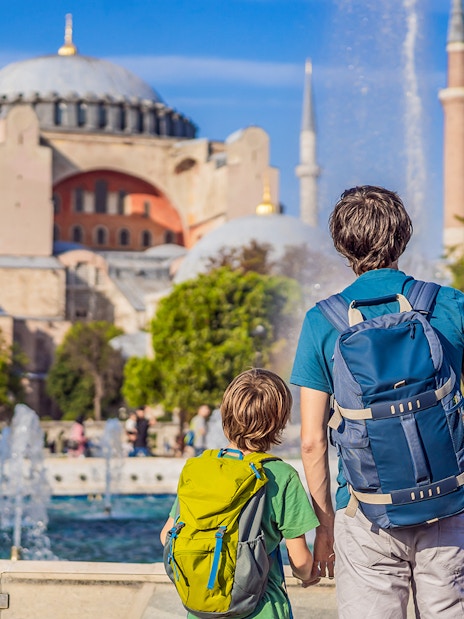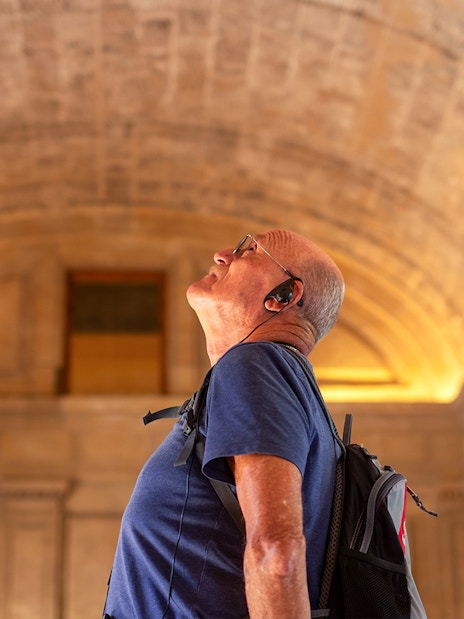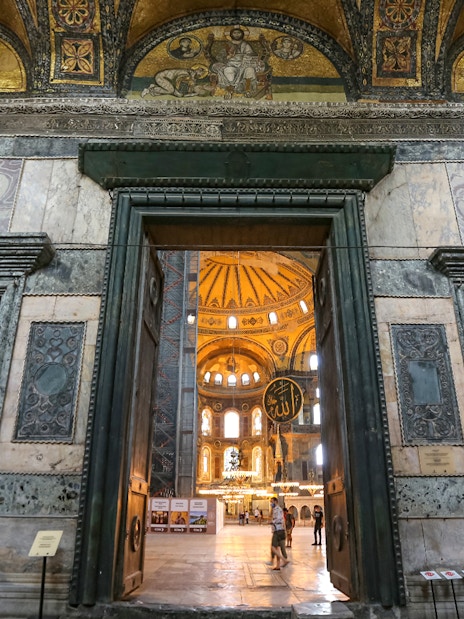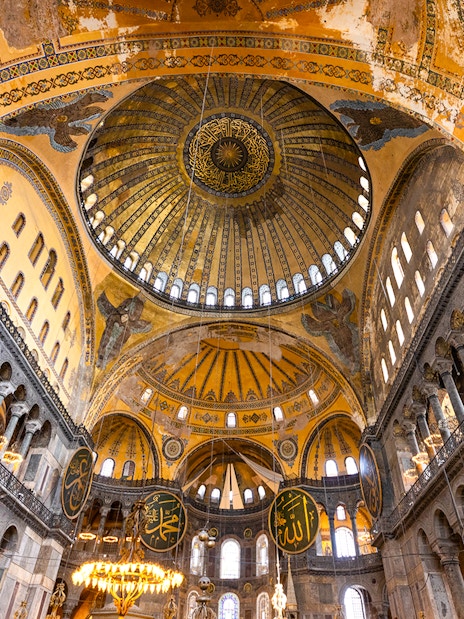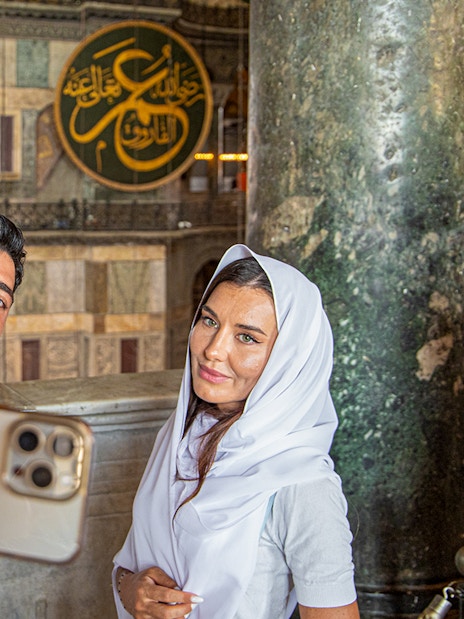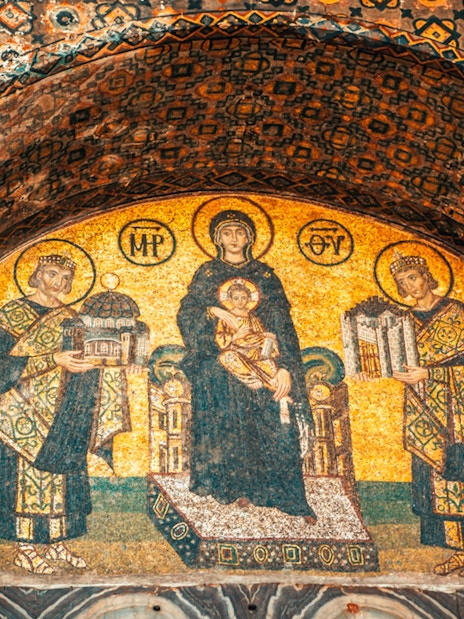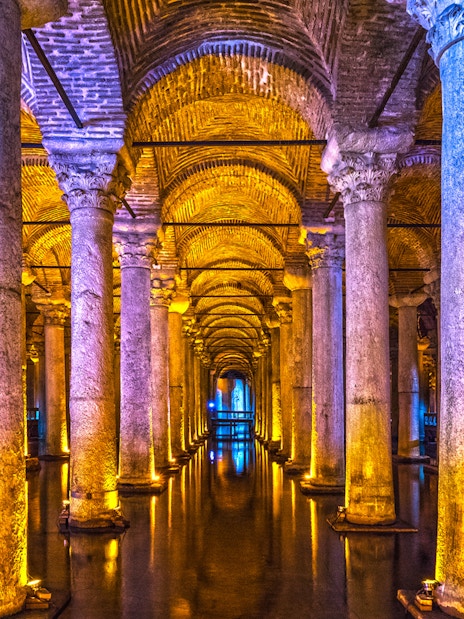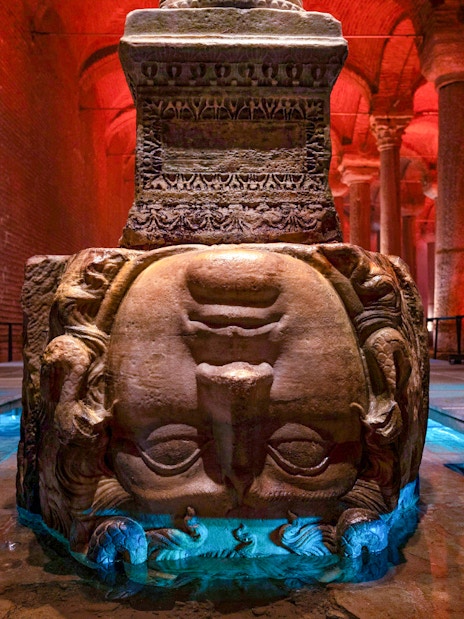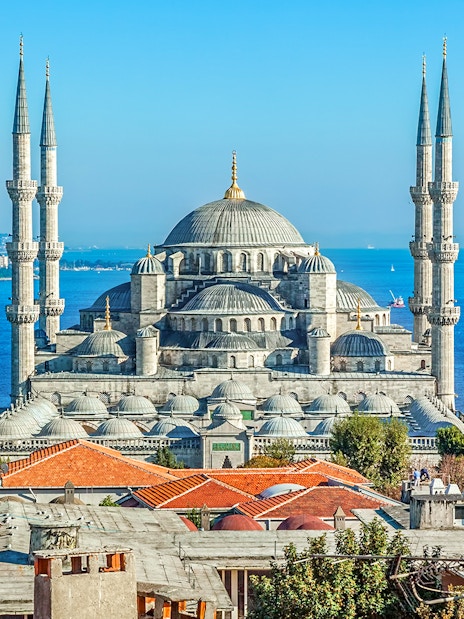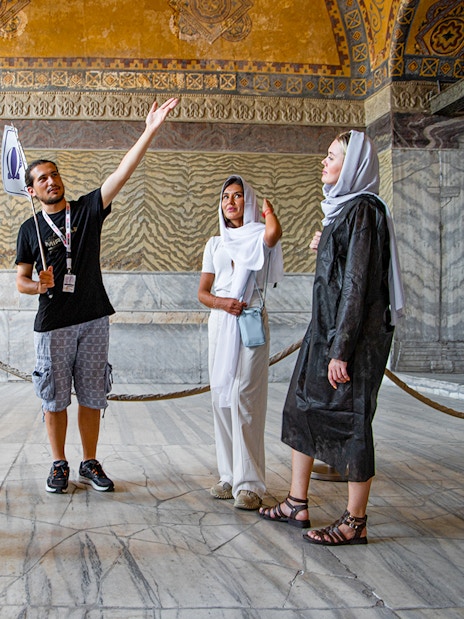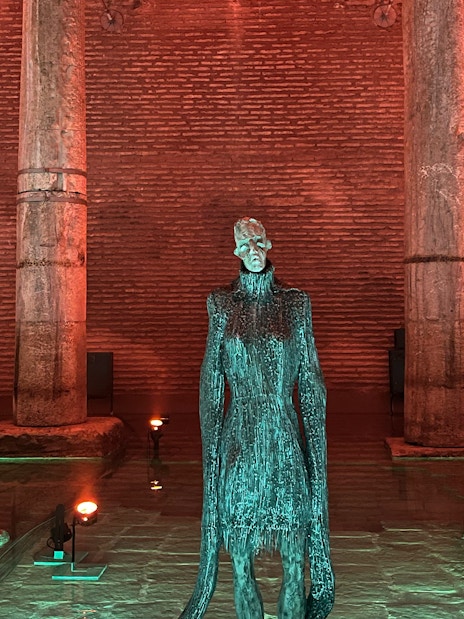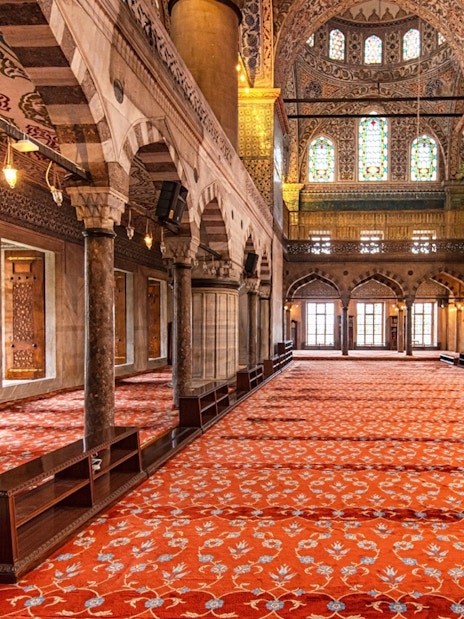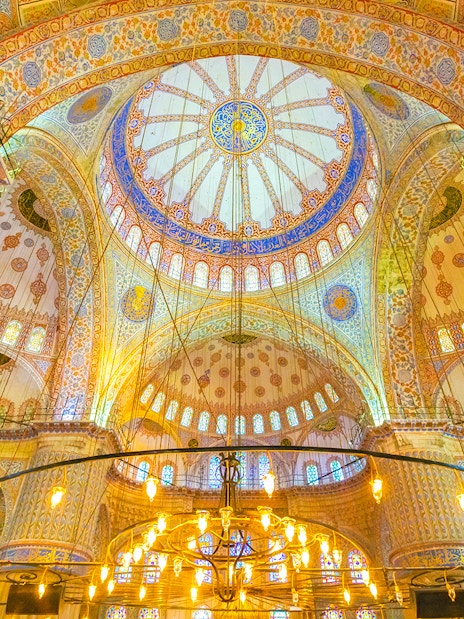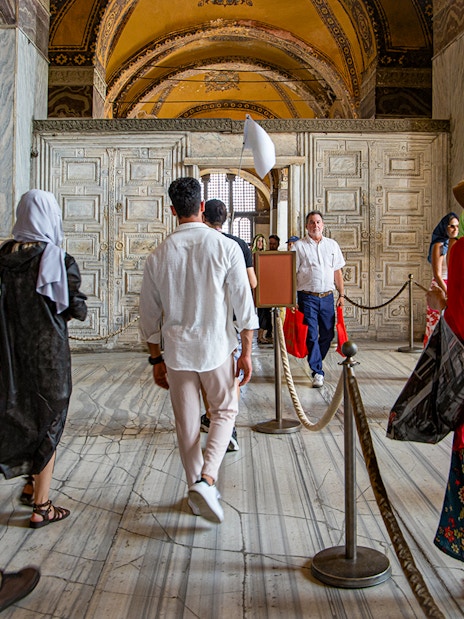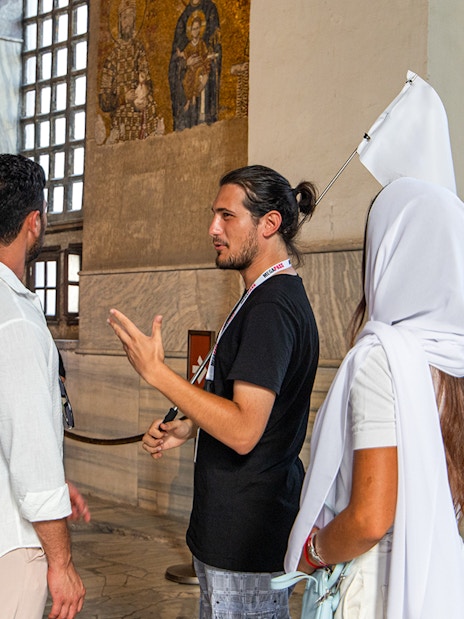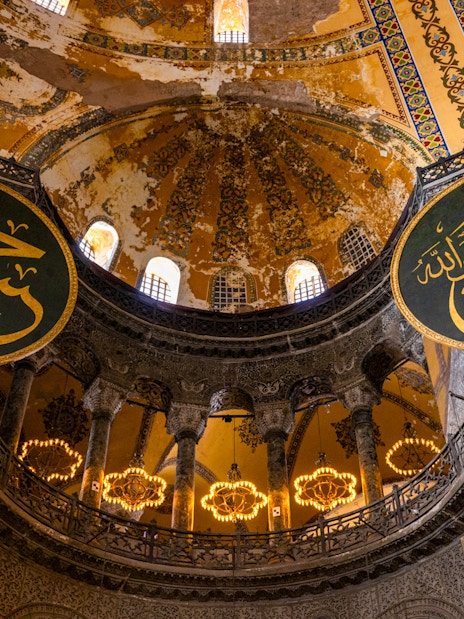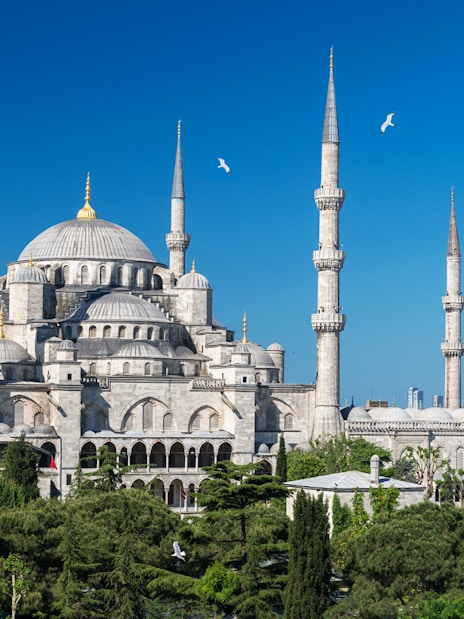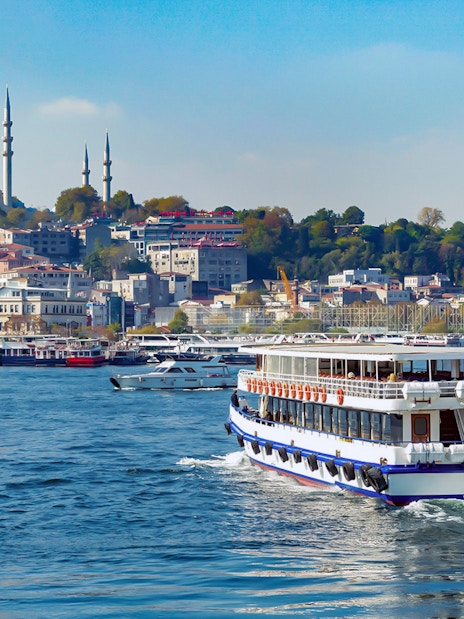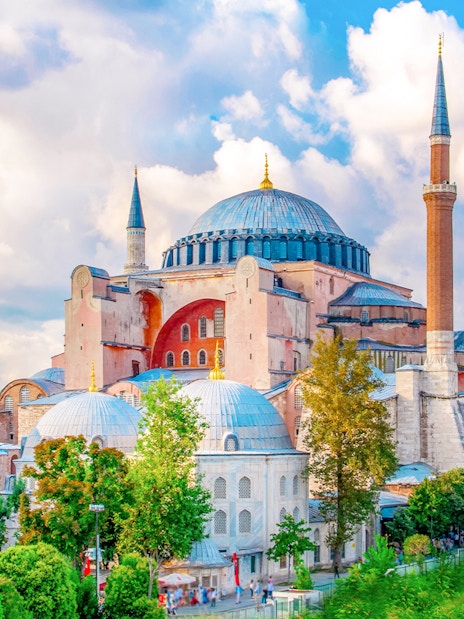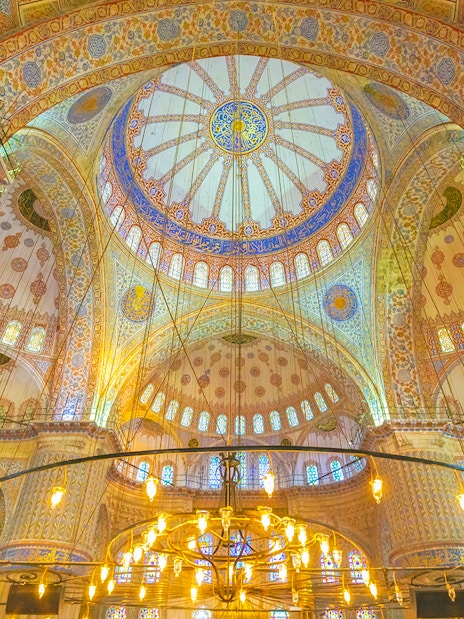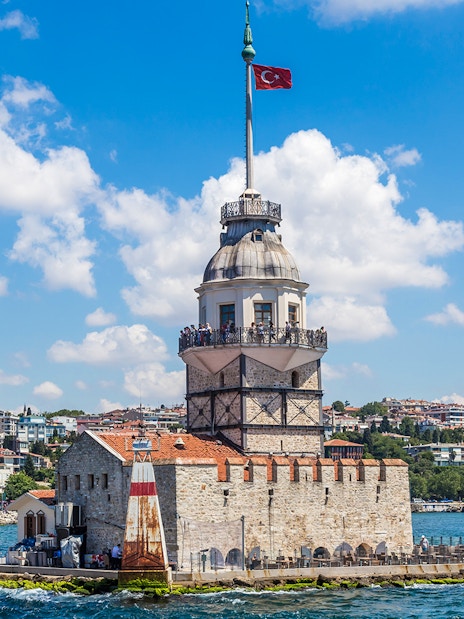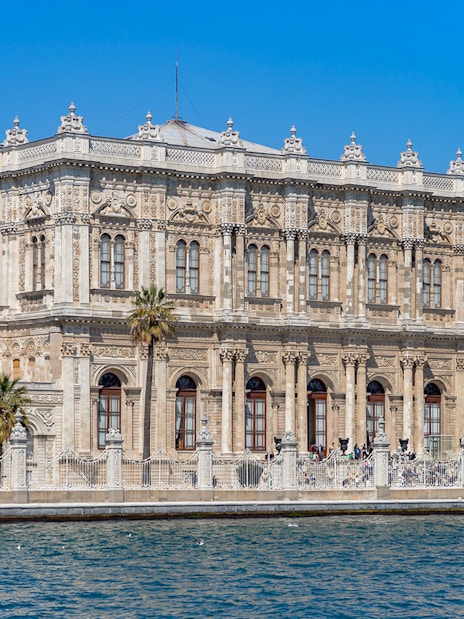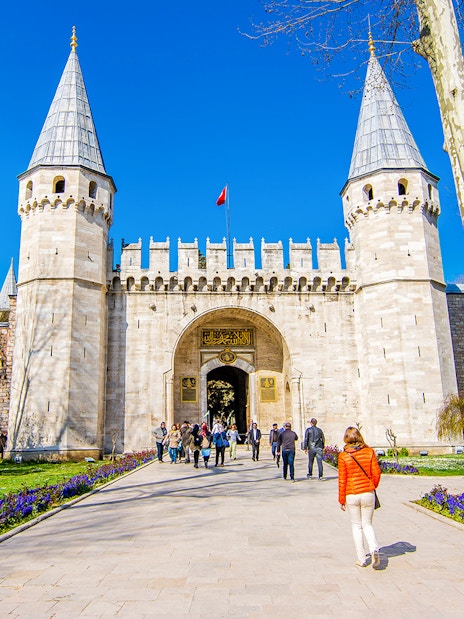- Hagia Sophia
- Hagia Sophia Museum
- History
- Architecture
- Inside
- Hagia Sophia Mosque
- Hagia Sophia Photos
- Hagia Sophia Church
Hagia Sophia Tours & Tickets
Headout is a brand trusted by millions of guests worldwide offering curated experiences to enjoy this attraction. This is not the venue's website.

- Bypass the ticketing queue with these skip-the-line tickets to Hagia Sophia (you must still go through the mandatory security line), designated as a UNESCO World Heritage Site with an audio guide available in 23 languages.
- Travel back in time and hop on a spiritual experience at Hagia Sophia, while gaining valuable insights about the Islamic and Byzantine heritage of the monument.
- Explore the marvel that once held the title of the world's largest place of worship for over a millennium, and check out the mosaics and the imperial dome.
- Enter the 2nd-floor visitors' area with skip-the-line access and explore the upper gallery at your own pace and convenience.
- Learn about the fascinating history of the oldest and fastest-built cathedral, its architecture, and heritage from your audio guide.
- Bypass the ticketing queue with these skip-the-line tickets to Hagia Sophia (you must still go through the mandatory security line), designated as a UNESCO World Heritage Site with an audio guide available in 23 languages.
- Travel back in time and hop on a spiritual experience at Hagia Sophia, while gaining valuable insights about the Islamic and Byzantine heritage of the monument.
- Explore the marvel that once held the title of the world's largest place of worship for over a millennium, and check out the mosaics and the imperial dome.
- Enter the 2nd-floor visitors' area with skip-the-line access and explore the upper gallery at your own pace and convenience.
- Learn about the fascinating history of the oldest and fastest-built cathedral, its architecture, and heritage from your audio guide.
Inclusions
- Skip the ticket line to Hagia Sophia
- Entry to Hagia Sophia visiting area
- Audio guide for both attractions (optional)
- Entry to the Hagia Sophia History Museum (optional)
- 10% discount at Dsign Cafe
Exclusions
- Skip the security line
- Tip: The building's ground floor has the best Instagram potential. Photograph the stunning interiors and beautiful ceiling from here.
- You skip the ticket lines but you cannot skip the security check.
- The security check can take up to 60 minutes during peak seasons.
- The prayer area in the first floor can only be entered by Turkish citizens.
- Women are required to cover their knees, shoulders, and chest. Hair should be partially covered with a scarf.
- Men are required to cover their knees and shoulders.
- If you do not have a scarf or body cover, you can buy them at the entrance (A scarf is €2 and a body cover is €3).
- This tour is not suitable for wheelchair users.
- Don't forget to carry your own headphones to listen to the audio guide.
- Due to the Friday prayer, the Mosque will be closed to tourists from 12pm to 2pm. For a smoother experience, it's recommend visiting after 4pm to avoid the lengthy security line anticipated between 2pm and 4pm.
- These tickets can't be cancelled or rescheduled.
Combos
Combo (Save 5%): Basilica Cistern + Hagia Sophia Skip-the-Line Tickets
from €68.40
€64.98
5% off
- Avail of a great cost benefit with this combo, giving you skip-the-line access to two of Istanbul’s iconic sites: the Basilica Cistern and Hagia Sophia.
- Marvel at the impressive Byzantine architecture of the Basilica Cistern, a 6th-century subterranean marvel with 336 massive columns.
- Soak in the Basilica Cistern experience with an optional multilingual audio guide providing intriguing insights into the history of this unique site.
- Step into the world-famous Hagia Sophia, once the largest place of worship for over a millennium with skip-the-line tickets and an audio guide.
- Enjoy the liberty to explore the magnificent mosaics and paintings at your own pace at the Hagia Sophia’s 2nd-floor Visitors' Center.
- Avail of a great cost benefit with this combo, giving you skip-the-line access to two of Istanbul’s iconic sites: the Basilica Cistern and Hagia Sophia.
- Marvel at the impressive Byzantine architecture of the Basilica Cistern, a 6th-century subterranean marvel with 336 massive columns.
- Soak in the Basilica Cistern experience with an optional multilingual audio guide providing intriguing insights into the history of this unique site.
- Step into the world-famous Hagia Sophia, once the largest place of worship for over a millennium with skip-the-line tickets and an audio guide.
- Enjoy the liberty to explore the magnificent mosaics and paintings at your own pace at the Hagia Sophia’s 2nd-floor Visitors' Center.
Inclusions
Basilica Cistern
- Skip-the-line entry to the Basilica Cistern
- Multilingual audio guide
Hagia Sophia
- Skip-the-line entry to Hagia Sophia
- Entry to Hagia Sophia visiting area
- Audio guide in 23 languages
Basilica Cistern
- Tip: Keep an eye out for the ghostly outlines of carp swimming in the water, they make for a great photo backdrop.
- This experience is wheelchair and pram/stroller accessible.
Hagia Sophia
- Tip: Look for the 'weeping column,' it's believed to have healing powers.
- This tour is not suitable for wheelchair users.
- You skip the ticket lines but you cannot skip the security check.
- The security check can take up to 60 minutes during peak seasons.
- Women should not wear knee-length shorts, skirts, or clothing with exposed shoulders or chests. Hair should be partially covered with a scarf.
- Men should not wear knee-length shorts or clothing with exposed shoulders.
- Clothes and scarves are available for purchase at the entrance of the attraction.
- Due to the Friday prayer, the Mosque will be closed to tourists from 12pm to 2pm. For a smoother experience, it's recommend visiting after 4pm to avoid the lengthy security line anticipated between 2pm and 4pm.
- These tickets can't be cancelled or rescheduled.
Combos
Istanbul Super Combo: Topkapi Palace + Hagia Sophia + Basilica Cistern Skip-the-Line Tickets with Audio Guide
from €122.40
€116.28
5% off
- This combo lets you skip the lines for Topkapi Palace, Hagia Sophia, and Basilica Cistern all in one go! Perfect for time-conscious travelers and history buffs.
- Explore the Sultan's lavish chambers at the Topkapi Palace, including the Harem, and marvel at the Imperial Treasury's jewels like the Topkapi Dagger.
- Witness the architectural marvel of Hagia Sophia and decipher the cryptic Viking runes etched by ancient visitors, alongside Islamic and Christian art.
- At Basilica Cistern, spot the column that is shaped like the feathers of a peacock, constructed in memory of the slaves who died building it.
- With multilingual audio guides, unlock the secrets of Topkapi Palace, Hagia Sophia's hidden murals, and the Basilica Cistern's haunting Medusa.
- This combo lets you skip the lines for Topkapi Palace, Hagia Sophia, and Basilica Cistern all in one go! Perfect for time-conscious travelers and history buffs.
- Explore the Sultan's lavish chambers at the Topkapi Palace, including the Harem, and marvel at the Imperial Treasury's jewels like the Topkapi Dagger.
- Witness the architectural marvel of Hagia Sophia and decipher the cryptic Viking runes etched by ancient visitors, alongside Islamic and Christian art.
- At Basilica Cistern, spot the column that is shaped like the feathers of a peacock, constructed in memory of the slaves who died building it.
- With multilingual audio guides, unlock the secrets of Topkapi Palace, Hagia Sophia's hidden murals, and the Basilica Cistern's haunting Medusa.
Inclusions
Topkapi Palace
- Skip-the-ticket-line entry to Topkapi Palace
- Access to Harem Museum and Hagia Irene Museum
- Audio guide in Arabic, English, French, German, Russian, and Spanish
Hagia Sophia
- Skip-the-ticket-line entry to Hagia Sophia
- Audio guide in English, German, French, Italian, Russian, Spanish, and Turkish
Basilica Cistern
- Skip-the-ticket-line entry to Basilica Cistern
- Audio guide in English, German, French, Italian, Russian, Spanish, and Turkish
Topkapi Palace
- Tip: In the first courtyard, don't miss Hagia Irene, the oldest church in Istanbul and one of the oldest unreconstructed buildings in the world.
- This experience is wheelchair accessible.
Hagia Sophia
- Tip: Don't miss the Deesis mosaic, a recently uncovered Byzantine treasure depicting Virgin Mary, Jesus, and John the Baptist in a scene of intercession.
- This tour is not suitable for wheelchair users.
- The prayer area on the first floor can only be entered by Turkish citizens.
Basilica Cistern
- Tip: Look out for exhibitions which combine modern art installations with the cistern's ancient architecture, showcasing Istanbul's evolving character.
- This experience is wheelchair and pram/stroller accessible.
- These tickets can't be cancelled or rescheduled.
Guided Tours
Combo: Basilica Cistern + Blue Mosque + Hagia Sophia Guided Tour with Skip-the-Line Tickets
- Enjoy a guided tour of 3 of Istanbul’s iconic attractions with this one combo ticket that you can use in 1 day or over a span of 2 days.
- Skip the lines and enter the 4th-century Basilica Cistern, an underground reservoir from the Byzantine times, with an expert English-speaking guide.
- Admire the artwork here with raised wooden platforms and aesthetic vaulted ceilings as you to the mystery of Medusa heads from Greek mythology.
- Soak up the architectural charm and beauty of the Blue Mosque as you admire the hand-painted blue tiles that adorn the mosque’s interior walls.
- See the 5 main domes, 6 minarets, and 8 secondary domes and learn about Byzantine and Ottoman heritage, Islam and Istanbul’s rich heritage from your guide.
- Enter Hagia Sophia with skip-the-line access, an important monument both for the Byzantine and the Ottoman Empires and admire its architectural beauty.
- Enjoy a guided tour of 3 of Istanbul’s iconic attractions with this one combo ticket that you can use in 1 day or over a span of 2 days.
- Skip the lines and enter the 4th-century Basilica Cistern, an underground reservoir from the Byzantine times, with an expert English-speaking guide.
- Admire the artwork here with raised wooden platforms and aesthetic vaulted ceilings as you to the mystery of Medusa heads from Greek mythology.
- Soak up the architectural charm and beauty of the Blue Mosque as you admire the hand-painted blue tiles that adorn the mosque’s interior walls.
- See the 5 main domes, 6 minarets, and 8 secondary domes and learn about Byzantine and Ottoman heritage, Islam and Istanbul’s rich heritage from your guide.
- Enter Hagia Sophia with skip-the-line access, an important monument both for the Byzantine and the Ottoman Empires and admire its architectural beauty.
Inclusions
Basilica Cistern
- 30-min guided tour of the Basilica Cistern
- Skip-the-line ticket to Basilica Cistern
- Expert English-speaking guide
Blue Mosque
- 60-min guided tour of the Blue Mosque
- Entry to the Blue Mosque
- English-speaking guide
Hagia Sophia
- 60-min guided tour of Hagia Sophia
- Skip-the-line tickets to Hagia Sophia
- English-speaking tour guide
- Audio guide inside Hagia Sophia
Basilica Cistern
- Tip: The underground cistern is dark and damp, which can lead to a drop in temperature. It’s best to carry a light cardigan to keep yourself warm.
Blue Mosque
- Tip: Look out for decorations and items inside the mosque inscribed with the names of the caliphs and verses from the Quran.
- This tour is not available on Tuesdays.
- Please note that the security line can take up to 60 minutes in the high season.
- If you do not have a scarf or body cover, you can buy them at the entrance (a scarf is 1€ and a body cover is 3€).
Hagia Sophia
- Tip: Don’t forget to make a wish at one of Hagia Sophia’s columns, known as the ‘wishing column.’ Legend has it that if you poke your finger through a hole in the column and your finger emerges wet, your wishes will come true and you’ll be cured of any illness. No harm in trying!
- This tour is not available on Tuesdays.
- Please expect a considerable wait time as you enter the attraction, especially during holidays and weekends.
- Security checks at Hagia Sophia take approximately 30 minutes.
- Since it is a religious place, guests are requested to wear clothes that cover their arms and head.
- While photography is allowed, all visitors are requested to refrain from turning on flash and using bulky accessories like tripods.
- Hagia Sophia may be closed during prayer times as it is a place of religious worship.
- These tickets are valid for 2 days from the date of experience.
- You can cancel these tickets up to 24 hours before the experience begins and get a full refund.
- These tickets are valid for 2 days from the date of purchase.
- Absorb the rich Byzantine and Islamic past of Hagia Sophia for an hour with an expert historian. Explore at your own pace afterward.
- Skip the ticket lines and head straight to the fun. Let your expert guide offer insights into different elements that make Hagia Sophia a historic marvel.
- Bid your guide goodbye, and take your time to listen to stories of Hagia Sophia in multiple languages, with your audio guide, as you continue exploring.
- Click insta-worthy pics of panoramic views from the visitors' area, which serves as a vantage point for photo-ops.
- Upgrade your ticket to include a guided tour of Blue Mosque or opt to add a 1-hour guided tour of the Old City with a Bosphorus Cruise.
- Absorb the rich Byzantine and Islamic past of Hagia Sophia for an hour with an expert historian. Explore at your own pace afterward.
- Skip the ticket lines and head straight to the fun. Let your expert guide offer insights into different elements that make Hagia Sophia a historic marvel.
- Bid your guide goodbye, and take your time to listen to stories of Hagia Sophia in multiple languages, with your audio guide, as you continue exploring.
- Click insta-worthy pics of panoramic views from the visitors' area, which serves as a vantage point for photo-ops.
- Upgrade your ticket to include a guided tour of Blue Mosque or opt to add a 1-hour guided tour of the Old City with a Bosphorus Cruise.
Inclusions
- 1-hour guided tour of Hagia Sophia (as per option selected)
- 1-hour guided tour of Hagia Sophia and Blue Mosque (as per option selected)
- 1-hour guided tour of Hagia Sophia and Old City (as per option selected)
- English-speaking guide
- Skip-the-line entry to Hagia Sophia visitors' area
- Audio guide for Hagia Sophia
- 2-hour Bosphorus cruise (as per option selected)
- Audio guide for cruise in English, French, German, Italian, Polish, Russian, Spanish, Turkish, Arabic, and Chinese (as per option selected)
- Entry to Blue Mosque (as per option selected)
- Audio guide for Blue Mosque (as per option selected)
- Tip: There are many great restaurants located along the Bosphorus. Enjoy a delicious meal with a stunning view of the water.
- The prayer area on the first floor can only be entered by Turkish citizens.
- This tour is not suitable for wheelchair users.
- In addition to midday and afternoon departures for the Bosphorus cruise, you can also opt for a special evening cruise at 6 PM, available from April to October.
- You skip the ticket lines but you cannot skip the security check. The security check can take up to 60 minutes during peak seasons.
- Hagia Sophia is under renovation, therefore, not all parts of the building are open to the public.
- You can cancel these tickets up to 24 hours before the experience begins and get a full refund.
Combos
Combo: Topkapi Palace + Hagia Sophia + Blue Mosque Guided Tours with Skip-the-Line Tickets
- Save big on your Istanbul trip with a combo to plan your visit across 3 days to Topkapi Palace, Hagia Sophia, and Blue Mosque.
- You have the flexibility to plan your visit across 3 days. Decide the best time to go that suits your vacation schedule.
- Lavish interiors and tales from Ottoman rule await at Topkapi Palace, along with captivating views of the Bosphorus river from the gardens.
- A cathedral, a mosque, and a museum - your guide will introduce you to the many facets of the architectural feat that is Hagia Sophia.
- With cascading domes, embellished high ceilings, and handcrafted blue ceramic tiles, Blue Mosque is a sight you won’t be forgetting any time soon.
- Save big on your Istanbul trip with a combo to plan your visit across 3 days to Topkapi Palace, Hagia Sophia, and Blue Mosque.
- You have the flexibility to plan your visit across 3 days. Decide the best time to go that suits your vacation schedule.
- Lavish interiors and tales from Ottoman rule await at Topkapi Palace, along with captivating views of the Bosphorus river from the gardens.
- A cathedral, a mosque, and a museum - your guide will introduce you to the many facets of the architectural feat that is Hagia Sophia.
- With cascading domes, embellished high ceilings, and handcrafted blue ceramic tiles, Blue Mosque is a sight you won’t be forgetting any time soon.
Inclusions
Topkapi Palace
- Skip-the-line entry to Topkapi Palace
- 1-hr English-guided tour
Hagia Sophia
- Skip-the-line entry to Hagia Sophia
- 1-hr English-guided tour
- Audio guide in 23 languages
Blue Mosque
- Entry to Blue Mosque
- 1-hr English-guided tour
Exclusions
- Skip-the-line entry to Blue Mosque
Topkapi Palace
- Tip: Try to plan your visit early morning on weekdays for lesser crowds and quieter explorations.
- The attraction is wheelchair accessible. However, access to some areas may be challenging due to uneven surfaces or steps.
Hagia Sophia
- Tip: The ground floor offers the best photo opportunities with its exquisite interiors and ceiling.
- This tour is not available on Tuesdays.
- Please note that during the high season, the waiting time for security checks is around 60 minutes.
- To enter the Blue Mosque and Hagia Sophia, women must cover their knees, shoulders, and chest. They must also partially cover their hair with a scarf. Men must cover their knees and shoulders. If you do not have a scarf or body cover, you can buy them at the entrance (a scarf is €1 and a body cover is €3).
- The attraction is wheelchair accessible. However, access to some areas may be challenging due to uneven surfaces or steps.
Blue Mosque
- Tip: The mosque is closed to visitors during prayer times for 90 minutes. It is advised to check the prayer schedule before planning your visit.
- This tour is not available on Tuesdays.
- Please note that during the high season, the waiting time for security checks is around 45 minutes.
- To enter the Blue Mosque and Hagia Sophia, women must cover their knees, shoulders, and chest. They must also partially cover their hair with a scarf. Men must cover their knees and shoulders. If you do not have a scarf or body cover, you can buy them at the entrance (a scarf is €1 and a body cover is €3).
- The attraction is wheelchair accessible. However, access to some areas may be challenging due to uneven surfaces or steps.
- You can cancel these tickets up to 24 hours before the experience begins and get a full refund.
- These tickets are valid for 3 days from the date of purchase.
- Want to save time and enjoy much flexibility? The Istanbul MegaPass is the one for you! Access multiple attractions with classic, premium, or deluxe passes, valid for 7 days!
- With your pass, enjoy a Bosphorus cruise, Blue Mosque tour, transportation card, route maps, and audio guides for all attractions—saving up to 37%!
- A Classic MegaPass allows you to choose 2 top attractions–Topkapi Palace, and Basilica Cistern, and activities like Turkish Hamam. Find the full list here
- For a more elevated experience choose the Premium or the all-inclusive Deluxe pass to explore more attractions and more flexibility at a great deal!
- Want to save time and enjoy much flexibility? The Istanbul MegaPass is the one for you! Access multiple attractions with classic, premium, or deluxe passes, valid for 7 days!
- With your pass, enjoy a Bosphorus cruise, Blue Mosque tour, transportation card, route maps, and audio guides for all attractions—saving up to 37%!
- A Classic MegaPass allows you to choose 2 top attractions–Topkapi Palace, and Basilica Cistern, and activities like Turkish Hamam. Find the full list here
- For a more elevated experience choose the Premium or the all-inclusive Deluxe pass to explore more attractions and more flexibility at a great deal!
Inclusions
- Choice of 2/4/9 of Istanbul's top attractions
- Attractions: Hagia Sophia, Topkapi Palace, Basilica Cistern, Dolmabahce Palace
- Cruises: Bosphorus cruise, Dinner cruise on Bosphorus with Turkish drinks and food
- Tours: Asian side walking tour, Blue Mosque tour,
- Access to hop on hop off bus tour
- Activities: Dervish Ceremony, Turkish bath & Hamam
- 5-ride transportation card
- Digital guide book
- City, tram & metro map
- There is no reservation needed for any activity except the Bosphorus Dinner cruise.
- Each pass is valid for 7 consecutive days including the first day of use.
- You can visit multiple attractions in a day but you can only visit each attraction once with this pass.
- You do have skip-the-line access but you will still need to go through security.
- You’ll receive an email shortly afterward with your tickets after you've picked a pass of your choice.
- If you're someone who likes a physical pass, you can print the PDF or show the PDF at the attraction so they scan your QR ticket.
- For the all-inclusive pass, you will also receive all your tickets.
- You can change the chosen attractions as many times as you want, or you can cancel the pass free of charge up to 1 day before the service date.
- You can cancel these tickets up to 24 hours before the experience begins and get a full refund.
Guided Tours
Istanbul Top Museums 3-Day Pass: Guided Tour + Entry Tickets & Free Bosphorus Cruise
- Enjoy a guided tour of Istanbul’s best iconic attractions with this one combo ticket that you can use in 1 day or over 2 or 3 days.
- Learn about the illustrious history of each of these landmarks from your expert English-speaking guide.
- Gain valuable insights about the iconic Hagia Sophia and the Blue Mosque from your guide before you enter.
- Explore Topkapi Palace and the Basilica Cistern while listening to interesting stories through an audio guide app available in 8 languages.
- Sail away on a relaxing 90-minute cruise of the Bosphorus Waterway as you admire the architectural beauty of Istanbul from a different perspective.
- Enjoy a guided tour of Istanbul’s best iconic attractions with this one combo ticket that you can use in 1 day or over 2 or 3 days.
- Learn about the illustrious history of each of these landmarks from your expert English-speaking guide.
- Gain valuable insights about the iconic Hagia Sophia and the Blue Mosque from your guide before you enter.
- Explore Topkapi Palace and the Basilica Cistern while listening to interesting stories through an audio guide app available in 8 languages.
- Sail away on a relaxing 90-minute cruise of the Bosphorus Waterway as you admire the architectural beauty of Istanbul from a different perspective.
Inclusions
- 60-min Topkapi Palace tour with skip-the-line entry
- 30-min Basilica Cistern tour with skip-the-line entry
- 60-min Hagia Sophia tour with entry
- 90-min Blue Mosque tour with entry
- 90-min Bosphorus Cruise ticket
- English-speaking guide for all attractions
- Audio app in 10 languages
Day 1
- Hagia Sophia Mosque
- Blue Mosque
- Bosphorus Cruise Tickets
Day 2
- Topkapi Palace
- Basilica Cistern
- Tip: Topkapi Palace's ground floor has the best Instagram potential. You get to photograph the stunning interiors and beautiful ceilings.
- The audio guide is available in English, French, German, Italian, Polish, Russian, Spanish, Turkish.
- Facilities: Pram/Stroller Accessibility.
- For Hagia Sophia, Women are required to cover their knees, shoulders, and chest. Their hair should be partially covered with a scarf. Men are required to cover their knees and shoulders. If you don't have a scarf or covering, it can be purchased at the entrance, at your own expense.
- With this admission ticket (except for Hagia Sophia), you will skip the ticket line, but not the security line. During high season, the security check could take up to 30 minutes.
- This tour is not wheelchair accessible and is not suitable for pets.
- Your guide will show you the way to each attraction, then you can set your own pace for exploring.
- You can cancel these tickets up to 24 hours before the experience begins and get a full refund.
- These tickets are valid for 3 days from the date of purchase.

